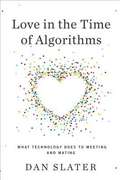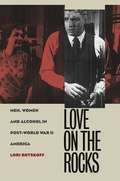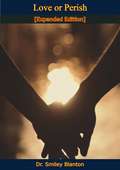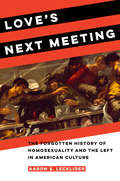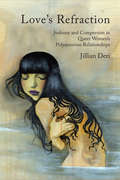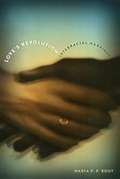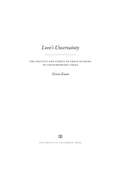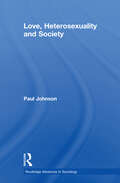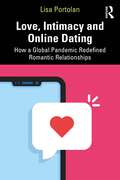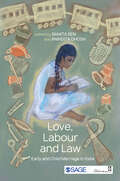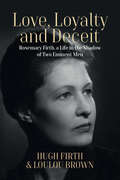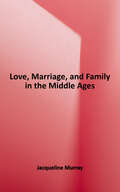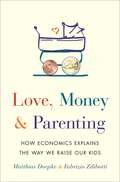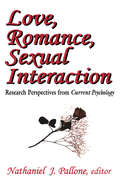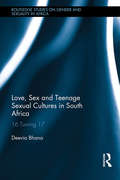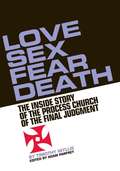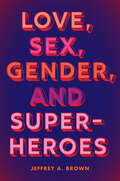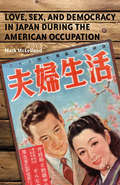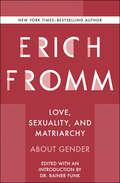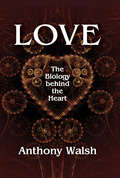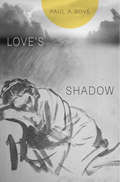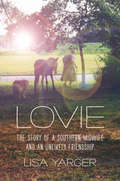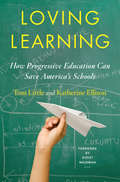- Table View
- List View
Love in the Time of Algorithms
by Dan Slater"If online dating can blunt the emotional pain of separation, if adults can afford to be increasingly demanding about what they want from a relationship, the effect of online dating seems positive. But what if it's also the case that the prospect of finding an ever more compatible mate with the click of a mouse means a future of relationship instability, a paradox of choice that keeps us chasing the illusive bunny around the dating track?" It's the mother of all search problems: how to find a spouse, a mate, a date. The escalating marriage age and declining marriage rate mean we're spending a greater portion of our lives unattached, searching for love well into our thirties and forties. It's no wonder that a third of America's 90 million singles are turning to dating Web sites. Once considered the realm of the lonely and desperate, sites like eHarmony, Match, OkCupid, and Plenty of Fish have been embraced by pretty much every demographic. Thanks to the increasingly efficient algorithms that power these sites, dating has been transformed from a daunting transaction based on scarcity to one in which the possibilities are almost endless. Now anyone--young, old, straight, gay, and even married--can search for exactly what they want, connect with more people, and get more information about those people than ever before. As journalist Dan Slater shows, online dating is changing society in more profound ways than we imagine. He explores how these new technologies, by altering our perception of what's possible, are reconditioning our feelings about commitment and challenging the traditional paradigm of adult life. Like the sexual revolution of the 1960s and '70s, the digital revolution is forcing us to ask new questions about what constitutes "normal": Why should we settle for someone who falls short of our expectations if there are thousands of other options just a click away? Can commitment thrive in a world of unlimited choice? Can chemistry really be quantified by math geeks? As one of Slater's subjects wonders, "What's the etiquette here?" Blending history, psychology, and interviews with site creators and users, Slater takes readers behind the scenes of a fascinating business. Dating sites capitalize on our quest for love, but how do their creators' ideas about profits, morality, and the nature of desire shape the virtual worlds they've created for us? Should we trust an industry whose revenue model benefits from our avoiding monogamy? Documenting the untold story of the online-dating industry's rise from ignominy to ubiquity--beginning with its early days as "computer dating" at Harvard in 1965--Slater offers a lively, entertaining, and thought provoking account of how we have, for better and worse, embraced technology in the most intimate aspect of our lives.
Love on the Rocks
by Lori RotskoffIn this fascinating history of alcohol in postwar American culture, Lori Rotskoff draws on short stories, advertisements, medical writings, and Hollywood films to investigate how gender norms and ideologies of marriage intersected with scientific and popular ideas about drinking and alcoholism. After the repeal of Prohibition in 1933, recreational drinking became increasingly accepted among white, suburban, middle-class men and women. But excessive or habitual drinking plagued many families. How did people view the "problem drinkers" in their midst? How did husbands and wives learn to cope within an "alcoholic marriage"? And how was drinking linked to broader social concerns during the Great Depression, World War II, and the Cold War era?By the 1950s, Rotskoff explains, mental health experts, movie producers, and members of self-help groups like Alcoholics Anonymous and Al-Anon helped bring about a shift in the public perception of alcoholism from "sin" to "sickness." Yet alcoholism was also viewed as a family problem that expressed gender-role failure for both women and men. On the silver screen (in movies such as The Lost Weekend and The Best Years of Our Lives) and on the printed page (in stories by such writers as John Cheever), in hospitals and at Twelve Step meetings, chronic drunkenness became one of the most pressing public health issues of the day.Shedding new light on the history of gender, marriage, and family life from the 1920s through the 1960s, this innovative book also opens new perspectives on the history of leisure and class affiliation, attitudes toward consumerism and addiction, and the development of a therapeutic culture.
Love or Perish [Expanded Edition]
by Dr Smiley BlantonThe New York Times called this famous guide to a more rewarding life “sound and solid, the product of a richly furnished mind, a book of wisdom.” Written by one of America’s most distinguished psychiatrists, Dr. Smiley Blanton, it has already found its way into some 200,000 American homes. Hundreds of readers have written to the author saying they were helped, inspired—and wanted more.In response to these letters, Dr. Blanton added an enormously valuable new section showing how men and women of all ages can give themselves as second chance at happiness—this section, titled “On Making a Fresh Start,” is included in this Expanded Edition, which was first published in 1957.“I believe that it is possible to achieve an emotional change with the insight developed through books. Books can make a change in one’s philosophy and attitude toward life. That is why so many books of the world are so deeply cherished.“It is in this hope that I write, in an effort to bring to people the hard-won truths of my observation over many years of life and during more than forty years of practice in psychiatry.”—Dr. Smiley Blanton, Introduction
Love's Next Meeting: The Forgotten History of Homosexuality and the Left in American Culture
by Aaron LeckliderHow queerness and radical politics intersected—earlier than you thought. Well before Stonewall, a broad cross section of sexual dissidents took advantage of their space on the margins of American society to throw themselves into leftist campaigns. Sensitive already to sexual marginalization, they also saw how class inequality was exacerbated by the Great Depression, witnessing the terrible bread lines and bread riots of the era. They participated in radical labor organizing, sympathized like many with the early prewar Soviet Union, contributed to the Republicans in the Spanish Civil War, opposed US police and state harassment, fought racial discrimination, and aligned themselves with the dispossessed. Whether they were themselves straight, gay, or otherwise queer, they brought sexual dissidence and radicalism into conversation at the height of the Left's influence on American culture. Combining rich archival research with inventive analysis of art and literature, Love’s Next Meeting explores the relationship between homosexuality and the Left in American culture between 1920 and 1960. Aaron S. Lecklider uncovers a lively cast of individuals and dynamic expressive works, revealing remarkably progressive engagement with homosexuality among radicals, workers, and the poor. Leftists connected sexual dissidence with radical gender politics, antiracism, and challenges to censorship and obscenity laws through the 1920s and 1930s. In the process, a wide array of activists, organizers, artists, and writers laid the foundation for a radical movement through which homosexual lives and experiences were given shape and new political identities were forged. Love's Next Meeting cuts to the heart of some of the biggest questions in American history: questions about socialism, about sexuality, about the supposed clash still making headlines today between leftist politics and identity politics. What emerges is a dramatic, sexually vibrant story of the shared struggles for liberation across the twentieth century.
Love's Refraction
by Jillian DeriPopular wisdom might suggest that jealousy is an inevitable outcome of non-monogamous relationships. In Love's Refraction, Jillian Deri explores the distinctive question of how and why polyamorists - people who practice consensual non-monogamy - manage jealousy. Her focus is on the polyamorist concept of "compersion" - taking pleasure in a lover's other romantic and sexual encounters.By discussing the experiences of queer, lesbian, and bisexual polyamorous women, Deri highlights the social and structural context that surrounds jealousy. Her analysis, making use of the sociology of emotion and feminist intersectionality theory, shows how polyamory challenges traditional emotional and sexual norms.Clear and concise, Love's Refraction speaks to both the academic and the polyamorous community. Deri lets her interviewees speak for themselves, linking academic theory and personal experiences in a sophisticated, engaging, and accessible way.
Love's Revolution: Interracial Marriage
by Maria P. P. RootStudy of interracial marriage including anecdotal information from interviews and focus groups as well as statistical data.
Love's Uncertainty
by Teresa KuanLove's Uncertainty explores the hopes and anxieties of urban, middle-class parents in contemporary China. Combining long-term ethnographic research with analyses of popular child-rearing manuals, television dramas, and government documents, Teresa Kuan bears witness to the dilemmas of ordinary Chinese parents, who struggle to reconcile new definitions of good parenting with the reality of limited resources. Situating these parents' experiences in the historical context of state efforts to improve "population quality," Love's Uncertainty reveals how global transformations are expressed in the most intimate of human experiences. Ultimately, the book offers a meditation on the nature of moral agency, examining how people discern, amid the myriad contingencies of life, the boundary between what can and cannot be controlled.
Love, Heterosexuality and Society (Routledge Advances in Sociology)
by Paul JohnsonHeterosexuality is a largely ‘silent’ set of practices and identities – it is assumed to be everywhere and yet often remains unnamed and unexplored. Despite recent changes in the theoretical understanding and representation of sexuality, heterosexuality continues to be socially normative. Forging a new agenda for the study of heterosexuality, this in-depth volume, the first research monograph to focus on heterosexuality and society, presents an empirical study of the construction, negotiation and enactment of heterosexual sexuality. Using detailed interview data, it investigates how heterosexuality, as both an identity and a set of practices, is accomplished through love relationships. Rather than assuming that romantic love is an outcome or expression of a pre-defined sexuality, Johnson explores how sexuality is brought to life through love. Situated in the ongoing theoretical debates concerning the relationship between gender and sexuality, Paul Johnson’s book shows how ways of loving are interwoven with the construction, practice, regulation and government of heterosexuality. Excellently written, this important book also looks at gender in society, and explores such areas as heterosexual subjectivities and the borders of desire. As such, the research it contains will be valuable for all students of sociology and gender studies.
Love, Inc.: Dating Apps, the Big White Wedding, and Chasing the Happily Neverafter
by Laurie EssigThe notion of “happily ever after” has been ingrained in many of us since childhood—meet someone, date, have the big white wedding, and enjoy your well-deserved future. But why do we buy into this idea? Is love really all we need? Author Laurie Essig invites us to flip this concept of romance on its head and see it for what it really is—an ideology that we desperately cling to as a way to cope with the fact that we believe we cannot control or affect the societal, economic, and political structures around us. From climate change to nuclear war, white nationalism to the worship of wealth and conspicuous consumption—as the future becomes seemingly less secure, Americans turn away from the public sphere and find shelter in the private. Essig argues that when we do this, we allow romance to blind us to the real work that needs to be done—building global movements that inspire a change in government policies to address economic and social inequality.
Love, Intimacy and Online Dating: How a Global Pandemic Redefined Romantic Relationships
by Lisa PortolanLove, Intimacy and Online Dating: How a Global Pandemic Redefined Romantic Relationships is an innovative work that explores the concept of intimacy during the COVID-19 pandemic. The book provides an overview of the online dating world and apps, the use of which gradually became common as the pandemic restricted people’s interaction in the physical world. The author’s extensive research conducted during the pandemic posits a comprehensive understanding of the individual’s motivation to join a dating app and explores its varied aspects. This thoroughly researched book explores the themes and elements of online dating and examines the users’ motivation for joining a dating app, for seeking intimacy as well as for self-presentation on the app. Portolan examines the underlying politics and role of infrastructure of dating apps and describes how gender, power, and intimacy intersect to create new intimacy phenomena. She also utilises her research to put forth the key concept of "Jagged Love", which describes a user’s cyclical relationship with dating apps during the pandemic, and the gap between a user’s act to seek familiar romantic narratives and the app’s inability to deliver against these ideas. The chapters further explore the differences between virtual and In Real Life (IRL) intimacy, the generation of gender and the emanation of stereotypical cultural ideals that the users sought through the apps. The book serves as an invaluable discussion on the pandemic’s impact on modifying the definitions of romance and intimacy. This book will be useful for highlighting the impact social factors can have on familiar concepts and the effects of the COVID-19 pandemic on the definition of love and intimacy, making it fascinating for students, academics and professionals interested in relationships, digital media and gender. It will also be useful in enhancing the comprehension of love and romance in the fields of social science.
Love, Labour and Law: Early and Child Marriage in India
by Samita Sen Anindita GhoshLove, Labour and Law: Early and Child Marriage in India is a path-breaking book on an issue that has not been analysed in depth for a while, perhaps since it does not affect the elite. Today, the child brides are usually from poor families. They are of 15–17 years as compared to much younger brides in the earlier times. The book discusses why child marriages persist despite numerous legislative and policy initiatives to ‘eliminate’ the practice. The chapters examine social and legal reforms to raise the age of marriage; contemporary education and health-related policy attempts at prevention; relationship of child marriage with child labour, sex work, human trafficking and other issues. Increasingly, there is greater resistance to marriages arranged by parents from the ‘child’ brides themselves who can now access institutional and bureaucratic support. How hopeful are these developments? The book goes beyond a simple policy focus on ‘elimination’ and provides a much-needed understanding of marriage and women’s agency within the context of the Indian marriage system.
Love, Loss, and Longing in Kashmir
by Sahba HusainIn this personal and passionate account, activist and researcher Sahba Husain documents her deeply engaged and empathetic involvement with the politicised terrain of Kashmir. As she meets people that she speaks with and, more importantly, listens to, she begins to question her own 'Indian' identity. Recognizing the anger, despair and helplessness of a people caught in conflict and violence, Husain forms deep friendships during her time working in the state. It is these relationships that form the backdrop of this book, in which Husain focuses on certain key areas: the health of a people, militancy and its changing meanings for local people and the state, impunity and the search for justice, migration and the longing for homes left behind, and women's activism in the faultlines of nation-state and community. A book of surprising beauty in its engagement with human relationships, of love for a land and a people and of hope for a future free of violence, Love, Loss, and Longing in Kashmir is a compelling and necessary read.
Love, Loyalty and Deceit: Rosemary Firth, a Life in the Shadow of Two Eminent Men
by Hugh Firth Loulou BrownHow much do we really know about our parents’ lives? What secrets lie in plain sight? This is the true story of hidden love within a small circle of some of the most acclaimed anthropologists of the 20th century. Told by Rosemary and Raymond Firth's son, and the daughter of Celia and Edmund Leach, the man Rosemary loved all her life, this part love-story, part biography, part social history is the tale of a highly influential circle of social anthropologists in Britain from the 1930s, through the Second World War, to the end of the century. The book explores their early influences, their insecurities, their flaws, struggles and achievements. It is a story of passion and commitment, but also of deceit and betrayal, including the inexplicable disappearance, death and alleged murder of a very close friend. It also narrates Rosemary's struggles for emotional and intellectual independence in the face of societal expectations of women and her own guilt, loss and self-doubt. From the Prologue: Rosemary loved many people in many different ways, but she loved two men in particular throughout most of her life. One was her husband, Raymond Firth, regarded by some as among the founding fathers of social anthropology. Yet she also retained a passionate devotion to her first love, Edmund Leach, who would subsequently become the public intellectual face of social anthropology in the later 1960s. Both separately and together they were part of the process of defining the nature of this still growing discipline in the first part of the mid-twentieth century.
Love, Marriage, and Family in the Middle Ages (Readings in Medieval Civilizations and Cultures #Volume Seven)
by Jacqueline MurrayThis reader of primary sources focuses on the burgeoning field of the medieval family. While much of what it means to be in love, or to marry, or to be part of a family has remained consistent over the past two millennia, dramatic changes have also taken place. This book now allows readers a vivid sense of what these issues, which make up so much of daily life, meant to those in the Middle Ages.
Love, Money, and Parenting: How Economics Explains the Way We Raise Our Kids
by Matthias Doepke Fabrizio ZilibottiAn international and historical look at how parenting choices change in the face of economic inequalityParents everywhere want their children to be happy and do well. Yet how parents seek to achieve this ambition varies enormously. For instance, American and Chinese parents are increasingly authoritative and authoritarian, whereas Scandinavian parents tend to be more permissive. Why? Love, Money, and Parenting investigates how economic forces and growing inequality shape how parents raise their children. From medieval times to the present, and from the United States, the United Kingdom, Germany, Italy, Spain, and Sweden to China and Japan, Matthias Doepke and Fabrizio Zilibotti look at how economic incentives and constraints—such as money, knowledge, and time—influence parenting practices and what is considered good parenting in different countries.Through personal anecdotes and original research, Doepke and Zilibotti show that in countries with increasing economic inequality, such as the United States, parents push harder to ensure their children have a path to security and success. Economics has transformed the hands-off parenting of the 1960s and ’70s into a frantic, overscheduled activity. Growing inequality has also resulted in an increasing “parenting gap” between richer and poorer families, raising the disturbing prospect of diminished social mobility and fewer opportunities for children from disadvantaged backgrounds. In nations with less economic inequality, such as Sweden, the stakes are less high, and social mobility is not under threat. Doepke and Zilibotti discuss how investments in early childhood development and the design of education systems factor into the parenting equation, and how economics can help shape policies that will contribute to the ideal of equal opportunity for all.Love, Money, and Parenting presents an engrossing look at the economics of the family in the modern world.
Love, Romance, Sexual Interaction: Research Perspectives from "Current Psychology"
by Nathaniel PalloneThis volume brings together in a single resource fourteen empirical studies examining a variety of emotions and behaviors covering many aspects of love, romance, and sexual interaction from recent issues of Current Psychology. Scholars from universities and research centers bring under the empiricist's microscope a variety of emotions and behaviors, ranging from dating relationships, criteria for the ideal mate held by both men and women, the relationship between perceptions of parents and partners in a direct test of psychoanalytic conceptualizations of mate selection, how the media influence perceptions about love and romance, sources of marital conflict, gender differences in responses to infidelity, and even the attitudes of "consumers" toward prostitution.Contributors and topics of discussion include: Albert Mehrabian and Jeffrey S. Blum, "Physical Appearance, Attractiveness, and the Mediating Effect of Emotions"; Gordon L. Flett, Paul L. Hewitt, Brenley Shapiro, and Jill Rayman, "Perfectionism, Beliefs, and Adjustment in Dating Relationships"; Robert Ervin Cramer, Jeffrey T. Schaefer, and Suzanne Reid, "Identifying the Ideal Mate: More Evidence for Male-Female Convergence"; Glenn Geher, "Perceived and Actual Characteristics of Parents and Partners: A Freudian Model of Mate Selection"; Claudia J. Haferkamp, "Beliefs about Relationships in Relation to Television Viewing, Soap Opera Viewing, and Self-Monitoring"; Blaine J. Flowers and Brooks Applegate, "Marital Satisfaction and Conventionalization Examined Didactically"; Claudia J. Haferkamp, "Dysfunctional Beliefs, Self-Monitoring, and Marital Conflict"; Emily A. Impett, Kristin P. Beals, and Letitia A. Peplau, "Testing the Investment Model of Relationship Commitment and Stability in a Longitudinal Study of Married Couples"; Richard Clements and Clifford H. Swensen, "Commitment to One's Spouse as a Predictor of Marital Quality among Older Couples"; Robert Ervin Cramer, William Todd Abraham, Lesley M. Johnson, Barbara Manning-Ryan, "Gender Differences in Subjective Distress to Emotional and Sexual Infidelity"; William Todd Abraham, Robert Ervin Cramer, Ana Maria Fernandez, and Eileen Mahler, "Infidelity, Race, and Gender"; Ami Rokach, "Strategies of Coping with Loneliness throughout the Lifespan."
Love, Sex and Teenage Sexual Cultures in South Africa: 16 turning 17 (Routledge Studies on Gender and Sexuality in Africa)
by Deevia BhanaLove, Sex and Teenage Sexual Cultures in South Africa interrupts the relative silence around teenage constructions of love in South Africa. Against the backdrop of gender inequalities, HIV and violence, the book situates teenage constructions of love and romance within the wider social and cultural context underwritten by the histories of apartheid, chronic unemployment, poverty, and the endless struggle to survive. By drawing on focus group discussions with African teenage men and women, the book addresses teenage Africans as active agents, providing a more nuanced picture of their desires and their dilemmas through which sexuality and love are experienced. The chapters in the book conceptualise desiring love, material love, pure love, forced love and fearing love. It argues that love is intrinsically linked to cultural practices and material realities which mold particular formations of teenage masculinities and femininities. This book will be of interest to academics, undergraduates, postgraduates and researchers in sociology, HIV, health and gender studies, development and postcolonial studies and African studies.
Love, Sex, Fear, Death
by Timothy Wyllie Adam ParfreyThe Process Church of the Final Judgment was the apocalyptic shadow side of the flower-powered '60s and perhaps the most notorious cult of modern times.Hundreds of black-cloaked devotees, often wearing a satanic "Goat of Mendes" and a swastika-like mandala, swept the streets of London, New York, Boston, Chicago, New Orleans, and Toronto, selling magazines and books with titles like Fear and Humanity is the Devil. And within the group's "Chapters," members would participate in "Midnight Meditations" beneath photographs of the Christ-like leader.Celebrities like Marianne Faithful, James Coburn, and Mick Jagger participated in Process publications, and Funkadelic, in its Maggot Brain album, reprinted Process' "Fear Issue."Process' "Death Issue" interviewed the freshly-imprisoned Charles Manson leading to conspiracy hysteria in such books as Ed Sanders' The Family and Maury Terry's The Ultimate Evil. A lawsuit against Sanders' Manson book led to the removal of its Process-themed chapter by Dutton.Love, Sex, Fear, Death is the shocking, surprising, and secretive inside story of The Process Church, which was later transformed into Foundation Faith of the Millennium, and most recently as the Utah-based animal sanctuary, Best Friends.Included will be text by Timothy Wyllie, a formative member of the Process and Foundation Faith organizations; interviews with other former Processeans; rare reproductions of Process magazines; never-before-seen photographs; and fascinating transcripts from holy books and legal actions.The special limited edition will be hardcover, signed, numbered, and slipcased, and it will include a facsimile edition of the notorious "Death Issue."
Love, Sex, Gender, and Superheroes: Photogenic French Literature And The Prehistory Of Cinematic Modernity
by Jeffrey A. BrownImpossibly muscular men and voluptuous women parade around in revealing, skintight outfits, and their romantic and sexual entanglements are a key part of the ongoing drama. Such is the state of superhero comics and movies, a genre that has become one of our leading mythologies, conveying influential messages about gender, sexuality, and relationships. Love, Sex, Gender, and Superheroes examines a full range of superhero media, from comics to films to television to merchandising. With a keen eye for the genre’s complex and internally contradictory mythology, comics scholar Jeffrey A. Brown considers its mixed messages. Superhero comics may reinforce sex roles with their litany of phallic musclemen and slinky femme fatales, but they also blur gender binaries with their emphasis on transformation and body swaps. Similarly, while most heroes have heterosexual love interests, the genre prioritizes homosocial bonding, and it both celebrates and condemns gendered and sexualized violence. With examples spanning from the Golden Ages of DC and Marvel comics up to recent works like the TV series The Boys, this study provides a comprehensive look at how superhero media shapes our perceptions of love, sex, and gender.
Love, Sex, and Democracy in Japan during the American Occupation
by Mark MclellandThis is the first book in English to examine, through material in the popular press, the radical changes that took place in Japanese ideas about sex, romance and male-female relations in the wake of Japan's defeat and occupation by Allied forces at the end of the Second World War.
Love, Sexuality, and Matriarchy: About Gender
by Erich Fromm&“[A] fascinating collection of essays&” on the complicated relations between men and women from the New York Times–bestselling author of The Art of Loving (The New York Times Book Review). The renowned social psychologist delves deep into the fraught relationship between genders, drawing upon the influential insights of Bachofen, Freud, Marx, and Briffault. Not primarily interested in the existence of anatomical and biological differences between the sexes, Fromm instead analyzes how these differences have been made use of throughout human history. Drawing from Bachofen&’s Mother Right, Fromm expounds on how matriarchal and patriarchal social structures determine relations between the sexes in essential ways, and how they are shaped by the dominant orientation of the social character at any given time. He posits that the most important question concerning gender relations is which characterological orientation determines human relationships: love or hate, love of life or fascination with force. Thus, it will not be gender conflict that will determine humanity&’s future but whether we opt for love of life or love of death. &“As these essays show, Fromm was a wide-ranging thinker whose writings sometimes manifested brilliant insights or practical wisdom.&” —Kirkus Reviews
Love: The Biology Behind the Heart (Insider Intelligence Ser.)
by Anthony WalshLove is a little word with a universe of meanings and has engaged people's interest throughout human history. The need to give and receive love lies deep within human nature. Philosophers, poets, theologians, sociologists, and scientists have all attempted to explain its exact origin, but is it an evolutionary adaptation, or a social construct?Walsh discusses that the nature of and need for love has biological origins. He draws upon Darwin's sexual selection theory to define the perceptions of love by infants through the process of experience-dependent brain wiring. He observes that mother love makes a child capable of loving and that father love makes a child feel worthy of love. He appraises the origin and purpose of romantic love in his discussions on sexual reproduction by looking at chemical and neurological responses to love and the influence of love on one's physical and mental health.With frequent quotes from literary masters like Shakespeare to orient one's scientific and humanistic understanding of love, Walsh goes on to explore various styles of romantic love, including monogamy, promiscuity, bartering love, and betrayed love; the effects of a skewed sex ratio on dating and mating practices; and the age-old quest for a perfect society populated by perfect people obeying the biblical command to "love one another."
Love’s Shadow
by Paul A. BovéA case for literary critics and other humanists to stop wallowing in their aestheticized helplessness and instead turn to poetry, comedy, and love.Literary criticism is an agent of despair, and its poster child is Walter Benjamin. Critics have spent decades stewing in his melancholy. What if instead we dared to love poetry? To choose comedy over Hamlet’s tragedy, romance over Benjamin’s suicide on the edge of France, of Europe, of civilization?Paul Bové challenges young lit critters to throw away their shades and let the sun shine in. Love’s Shadow is his three-step manifesto for a new literary criticism that risks sentimentality and melodrama and eschews self-consciousness. The first step is to choose poetry. There has been since the time of Plato a battle between philosophy and poetry. Philosophy has championed misogyny, while poetry has championed women, like Shakespeare’s Rosalind. Philosophy is ever so stringent; try instead the sober cheerfulness of Wallace Stevens. Bové’s second step is to choose the essay. He praises Benjamin’s great friend and sometime antagonist Theodor Adorno, who gloried in the writing of essays, not dissertations and treatises. The third step is to choose love. If you want a Baroque hero, make it Rembrandt, who brought lovers to life in his paintings.Putting aside passivity and cynicism would amount to a revolution in literary studies. Bové seeks nothing less, and he has a program for achieving it.
Lovie: The Story of a Southern Midwife and an Unlikely Friendship (Documentary Arts and Culture, Published in association with the Center for Documentary Studies at Duke University)
by Lisa YargerFrom 1950 to 2001, Lovie Beard Shelton practiced midwifery in eastern North Carolina homes, delivering some 4,000 babies to black, white, Mennonite, and hippie women; to those too poor to afford a hospital birth; and to a few rich enough to have any kind of delivery they pleased. Her life, which was about giving life, was conspicuously marked by loss, including the untimely death of her husband and the murder of her son.Lovie is a provocative chronicle of Shelton's life and work, which spanned enormous changes in midwifery and in the ways women give birth. In this artful exploration of documentary fieldwork, Lisa Yarger confronts the choices involved in producing an authentic portrait of a woman who is at once loner and self-styled folk hero. Fully embracing the difficulties of telling a true story, Yarger is able to get at the story of telling the story. As Lovie describes her calling, we meet a woman who sees herself working in partnership with God and who must wrestle with the question of what happens when a woman who has devoted her life to service, to doing God's work, ages out of usefulness. When I'm no longer a midwife, who am I? Facing retirement and a host of health issues, Lovie attempts to fit together the jagged pieces of her life as she prepares for one final home birth.
Loving Learning: How Progressive Education Can Save America's Schools
by Ayelet Waldman Katherine Ellison Tom LittleNoted educator Tom Little and Pulitzer Prize-winning journalist Katherine Ellison reveal the home-grown solution to turning American students into life-long learners. The longtime head of Park Day School, Tom Little embarked on a tour of 43 progressive schools across the country. In this book, his life's work, he interweaves his teaching experience, the knowledge he gleaned from his trip, and the history of Progressive Education. As Little and Katherine Ellison reveal, these educators and schools invigorate learning and promote inquisitiveness by allowing the curriculum to grow organically out of children's questions--whether they lead to studying the senses, working on a farm, or re-creating a desert ecosystem in the classroom. We see curious students draw on information across disciplines to think in imaginative yet practical ways, like in a "Mini-Maker Faire" or designing and building a chair from scratch. Becoming good citizens was another of Little's goals. He believed in the need for students to learn how to become advocates for themselves, from setting rules on the playground to engaging in issues of social justice in the wider community. Using the philosophy of Progressive Education, schools can prepare students to shape a vibrant future in the arts and sciences for themselves and the nation.
